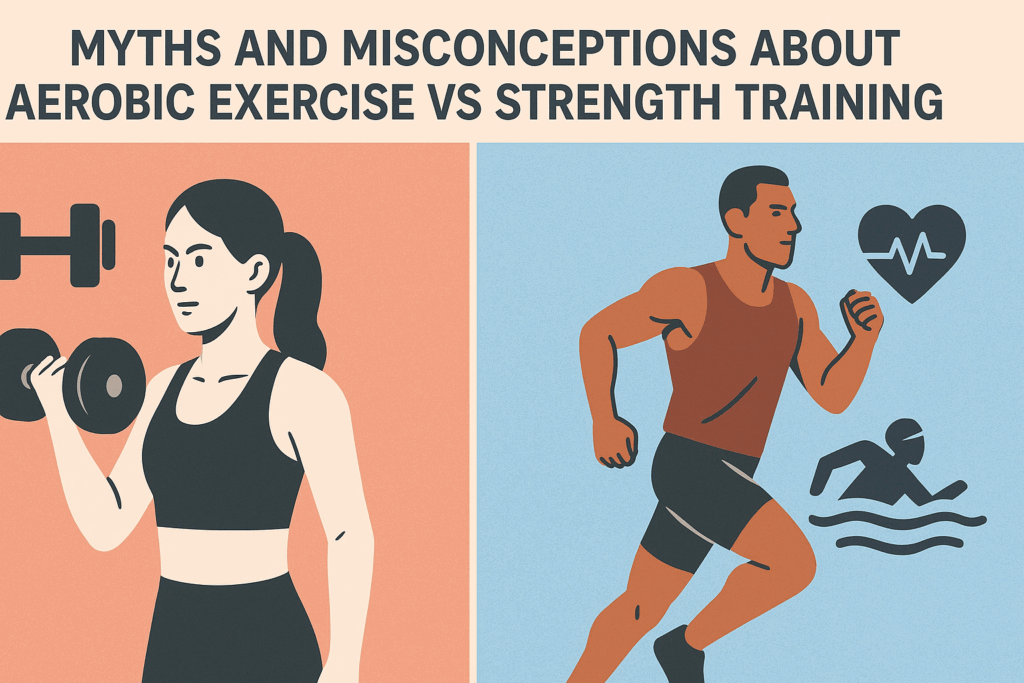Understanding the debate between aerobic exercise vs strength training is essential for anyone pursuing muscle-building strategies grounded in science and tailored for long-term success. These two foundational fitness modalities offer distinct physiological benefits, yet they are often misunderstood, misapplied, or viewed as mutually exclusive. While aerobic exercise is commonly associated with cardiovascular endurance, fat loss, and overall stamina, strength training is heralded for its ability to increase muscle mass, enhance metabolic function, and support skeletal integrity. Both forms of exercise play a pivotal role in optimizing health and fitness, and understanding how they compare is crucial for designing an effective training regimen that aligns with individual goals, lifestyles, and biological needs.
To explore this topic comprehensively, we must move beyond simplistic binaries and delve into the physiological mechanisms, hormonal responses, long-term adaptations, and training methodologies unique to aerobic exercise and strength training. Each discipline triggers different biochemical cascades in the body, leading to varied outcomes in muscle hypertrophy, endurance, cardiovascular function, and metabolic health. Rather than viewing aerobic exercise vs strength training as opposing camps, it is more productive to understand their interplay, areas of overlap, and how their integration can amplify results. This article presents an in-depth, research-informed analysis designed for readers with a solid academic foundation who seek clarity, nuance, and actionable insights into muscle-building strategies.
You may also like: The Ultimate Hypertrophy Workout Program for Building Strength and Size

The Science Behind Muscle Growth: Hypertrophy and Its Catalysts
Muscle hypertrophy, the enlargement of skeletal muscle fibers, is a complex biological process involving mechanical tension, metabolic stress, and muscle damage. Resistance training, the cornerstone of strength training, primarily stimulates type II muscle fibers—those responsible for power and explosive movements. These fibers exhibit greater potential for hypertrophy when subjected to progressive overload, which involves gradually increasing the weight, volume, or intensity of exercises over time. This adaptation is driven by muscle protein synthesis (MPS), which occurs when the rate of muscle repair and rebuilding surpasses the rate of muscle breakdown.
In contrast, aerobic exercise predominantly targets type I muscle fibers, which are more fatigue-resistant but exhibit a lower potential for growth. While not primarily designed for muscle hypertrophy, aerobic activities can indirectly support muscle maintenance by improving mitochondrial density, capillary proliferation, and oxygen delivery to muscle tissues. This enhancement in muscle endurance is particularly beneficial for recovery and sustainability in long-term training programs. However, aerobic exercise alone is insufficient to drive significant muscle mass gains, especially in experienced lifters or individuals with higher anabolic thresholds.
Hormonal responses also differ markedly between aerobic and strength training. Strength training triggers acute spikes in anabolic hormones such as testosterone, growth hormone, and insulin-like growth factor-1 (IGF-1), all of which facilitate muscle growth. In contrast, prolonged aerobic sessions may increase cortisol levels—a catabolic hormone that, when chronically elevated, can inhibit muscle protein synthesis and promote muscle degradation. The key, therefore, lies in balancing both exercise modalities to optimize hormonal profiles and minimize interference.

Aerobic Exercise vs Strength Training: Metabolic Impact and Energy Systems
When comparing aerobic exercise vs strength training from a metabolic perspective, the distinction becomes increasingly evident. Aerobic exercise relies heavily on the oxidative phosphorylation energy system, which uses oxygen to metabolize carbohydrates and fats into adenosine triphosphate (ATP). This process is highly efficient for sustained, moderate-intensity activity such as running, cycling, or swimming. As a result, aerobic training excels at improving cardiovascular efficiency, increasing stroke volume, and enhancing the body’s ability to utilize fat as a fuel source during prolonged exertion.
Strength training, on the other hand, predominantly engages the phosphagen and glycolytic systems. These anaerobic pathways provide rapid bursts of energy by breaking down creatine phosphate and glucose, respectively. This allows for high-intensity, short-duration efforts such as squats, deadlifts, or bench presses. While these systems are less efficient in terms of total energy production, they are essential for maximal force generation and muscular contraction. The repeated stress placed on muscles during resistance training prompts metabolic adaptations that elevate basal metabolic rate (BMR), increase insulin sensitivity, and enhance nutrient partitioning—all crucial for body recomposition.
A crucial distinction lies in the post-exercise metabolic response. Known as excess post-exercise oxygen consumption (EPOC), this phenomenon describes the increased rate of oxygen intake following strenuous activity. Strength training induces a more pronounced EPOC effect than aerobic exercise, resulting in elevated calorie expenditure for hours after the workout ends. This has implications for fat loss and lean mass retention, as the body continues to burn calories at a heightened rate during recovery. Therefore, while aerobic exercise is more effective for burning calories during the workout itself, strength training offers a longer-lasting metabolic boost that contributes to improved body composition.

Aerobic Exercise vs Strength Training: Cardiovascular and Muscular Endurance Benefits
From a cardiovascular standpoint, aerobic exercise holds a clear advantage. It enhances cardiac output, reduces resting heart rate, and improves endothelial function, which collectively reduce the risk of heart disease, hypertension, and stroke. Regular aerobic training also promotes greater blood volume and increased capillary density, facilitating more efficient oxygen and nutrient delivery to working muscles. These adaptations support overall cardiovascular health and allow individuals to perform physical tasks for extended periods without fatigue.
While strength training does contribute to cardiovascular improvements, particularly through circuit-style or high-volume lifting protocols, its primary benefits lie in enhancing muscular strength and endurance. This form of exercise increases the number and size of myofibrils within muscle fibers, enabling them to generate greater force and resist fatigue. Moreover, strength training strengthens connective tissues such as tendons and ligaments, reducing the risk of injury during both athletic and everyday activities.
Interestingly, incorporating aerobic training into a strength-based program can yield synergistic effects. Improved cardiovascular capacity enhances recovery between sets, facilitates faster removal of metabolic byproducts, and increases work capacity during high-repetition training. Conversely, the enhanced musculature developed through resistance training supports better posture, joint stability, and movement efficiency during aerobic activity. This symbiotic relationship suggests that integrating both exercise types—rather than choosing one over the other—can lead to a more comprehensive fitness profile.

Adaptations and Recovery in Aerobic Exercise vs Strength Training
Adaptation is a fundamental principle in exercise science, and the body’s response to training stimuli is governed by the SAID principle (Specific Adaptation to Imposed Demands). This means that aerobic and strength training elicit different adaptations based on the nature, intensity, and duration of the exercise performed. For aerobic training, adaptation manifests as increased mitochondrial density, improved oxidative enzyme activity, and enhanced glycogen storage in type I muscle fibers. These changes enable the body to sustain longer bouts of physical activity with reduced perceived exertion.
Strength training, in contrast, promotes neural adaptations such as improved motor unit recruitment, synchronization, and rate coding. These changes occur early in a training program and contribute to rapid strength gains even before significant muscle hypertrophy is evident. Over time, structural adaptations such as increased cross-sectional area of muscle fibers, enhanced bone mineral density, and improved tendon stiffness emerge. These changes not only boost performance but also serve as protective mechanisms against musculoskeletal injuries and age-related decline.
Recovery protocols also differ between the two modalities. Aerobic exercise, particularly at moderate intensity, places less mechanical strain on the body and generally requires shorter recovery periods. However, high-intensity aerobic sessions or endurance events can lead to central nervous system fatigue and necessitate longer recovery. Strength training, especially when performed at high intensities or volumes, creates significant microtrauma in muscle tissues, requiring sufficient recovery to allow for repair and growth. This includes adequate sleep, nutrition—particularly protein intake—and active recovery strategies such as mobility work, foam rolling, and low-intensity movement.
Hormonal and Neurological Considerations in Training Outcomes
One of the most critical differences between aerobic exercise and strength training lies in their hormonal and neurological impacts. Strength training, particularly compound lifts performed at high intensity, stimulates the release of anabolic hormones including testosterone, growth hormone, and IGF-1. These hormones facilitate muscle protein synthesis, promote tissue repair, and contribute to lean mass gains. Furthermore, heavy resistance training improves neuromuscular efficiency by enhancing the brain’s ability to communicate with muscle fibers.
Aerobic exercise, while beneficial for cardiovascular health, can sometimes induce a catabolic environment if not balanced correctly. Prolonged aerobic sessions may elevate cortisol levels, which, in excess, can impede muscle growth and promote protein breakdown. This is particularly relevant for individuals who prioritize muscle mass and body composition as primary goals. However, moderate aerobic exercise supports hormonal balance by improving insulin sensitivity, reducing systemic inflammation, and enhancing mood through endorphin release.
Neurologically, aerobic training increases brain-derived neurotrophic factor (BDNF), which supports neuroplasticity and cognitive function. This effect is especially important in older adults or individuals at risk for neurodegenerative diseases. Strength training also confers cognitive benefits, including improved executive function, memory, and spatial awareness, due in part to increased blood flow and hormonal responses. Thus, both exercise modalities contribute to neurological health in distinct but complementary ways.

Designing an Integrated Training Program: Maximizing Synergy
Given the unique benefits of both aerobic exercise and strength training, an integrated approach often yields the most comprehensive results. Designing a balanced program involves strategic planning to prevent interference effects—where one modality hampers the adaptations of the other. This is particularly relevant in concurrent training, where strength and endurance sessions are performed within the same timeframe. Research suggests that performing aerobic exercise after strength training or on separate days minimizes potential interference and allows both systems to adapt optimally.
Program variables such as intensity, volume, frequency, and rest periods must be tailored to the individual’s goals. For those prioritizing muscle growth, resistance training should take precedence, with aerobic sessions scheduled strategically to enhance recovery and cardiovascular conditioning without compromising strength gains. Low-impact aerobic modalities such as rowing, swimming, or cycling are particularly beneficial, as they reduce joint stress while promoting cardiovascular health.
Nutritional support is another critical component. Adequate protein intake, ideally distributed evenly across meals, is essential for muscle repair and hypertrophy. Carbohydrates play a vital role in replenishing glycogen stores depleted during both aerobic and anaerobic training. Fats support hormone production and overall energy balance. Hydration, micronutrient intake, and supplementation—such as creatine monohydrate or branched-chain amino acids (BCAAs)—can further optimize performance and recovery.

Myths and Misconceptions About Aerobic Exercise vs Strength Training
Despite abundant scientific evidence supporting the benefits of both aerobic exercise and strength training, misconceptions persist in popular fitness discourse. One common myth is that aerobic exercise inhibits muscle growth, a belief rooted in concerns about hormonal interference and caloric expenditure. While excessive endurance training without adequate recovery and nutrition can impair hypertrophy, moderate aerobic activity can enhance recovery, improve metabolic health, and support sustainable training practices.
Another misconception is that strength training is only for bodybuilders or athletes. In reality, resistance training is vital for all demographics, including older adults, women, and individuals with chronic conditions. It preserves muscle mass, prevents osteoporosis, supports functional independence, and improves metabolic health. Similarly, aerobic exercise is often undervalued by those focused solely on aesthetics. Yet its benefits—ranging from improved heart health to enhanced mental clarity—are indispensable for holistic well-being.
A more nuanced understanding of these exercise modalities reveals that the dichotomy between them is largely artificial. Rather than choosing one at the expense of the other, individuals can benefit from a tailored approach that leverages the strengths of each. By dispelling myths and embracing evidence-based practices, fitness enthusiasts can achieve more balanced, effective, and sustainable results.
Frequently Asked Questions: Enhancing Muscle-Building Strategies with Aerobic Exercise vs Strength Training
1.Can aerobic exercise interfere with strength gains in a combined training program?
When aerobic exercise and strength training are combined improperly, interference may occur, particularly when endurance sessions are long and scheduled too close to resistance workouts. This effect is most pronounced when high-frequency aerobic sessions lead to central nervous system fatigue, compromising strength training intensity and recovery. However, when managed strategically, the two modalities can coexist without negative outcomes. Scheduling aerobic sessions on alternate days or after resistance workouts can prevent performance decrements. Moreover, incorporating low-impact aerobic forms such as swimming or cycling may reduce cumulative fatigue and better support muscle retention.
2.What role does genetic predisposition play in balancing aerobic exercise and strength training?
Genetic factors significantly influence how individuals respond to aerobic exercise and strength training. Some people possess a higher proportion of type I muscle fibers, which favors aerobic efficiency and endurance-based activities. Others are more naturally inclined to benefit from strength-focused programs due to a greater prevalence of type II fibers. Understanding your genetic strengths can help you tailor your workout distribution to maximize results. Today, advanced fitness DNA testing provides insights into your recovery speed, muscle composition, and aerobic capacity, allowing for a more precise integration of training approaches.
3.Can combining aerobic exercise and strength training improve mental health more effectively than either alone?
Emerging research suggests that combining aerobic exercise and strength training provides superior psychological benefits compared to either in isolation. Aerobic activity is well-documented to increase levels of serotonin and endorphins, helping to alleviate symptoms of depression and anxiety. Strength training, on the other hand, improves self-esteem and cognitive performance through increased neural stimulation and hormonal shifts. Together, they offer a comprehensive approach to mental well-being by targeting both mood regulation and resilience. This dual-action strategy is particularly useful for individuals managing high-stress lifestyles or mental health conditions.
4.How can time-constrained individuals benefit from aerobic exercise vs strength training without compromising results?
For those with limited time, the key lies in integrating hybrid training techniques that blend elements of aerobic exercise and strength training into efficient, single-session formats. Methods such as high-intensity interval training (HIIT), circuit training, and metabolic resistance workouts offer both cardiovascular stimulation and muscular overload. These formats minimize time while maintaining workout density and calorie burn. Strategic exercise selection—favoring compound movements and minimal rest intervals—also maximizes muscle engagement and endurance in compressed timeframes. This approach allows even the busiest individuals to reap the benefits of both exercise modalities.
5.Is one modality better for older adults: aerobic exercise or strength training?
In aging populations, both aerobic exercise and strength training serve critical but distinct roles. Aerobic activity improves cardiovascular health, reduces the risk of stroke, and enhances pulmonary function, which are crucial in preventing age-related disease. Strength training, meanwhile, combats sarcopenia—the loss of muscle mass and strength with age—and supports balance, bone density, and joint integrity. A well-rounded program that includes both modalities leads to improved mobility, independence, and quality of life in older adults. Notably, resistance training may take precedence in very elderly individuals due to its direct impact on fall prevention and muscular retention.
6.What does current research say about the long-term sustainability of aerobic exercise vs strength training?
Studies examining long-term adherence show that sustainability depends on personal preferences, perceived benefits, and lifestyle fit. Many people find aerobic exercise more accessible and socially engaging, especially when it involves outdoor or group activities like hiking or dancing. However, strength training shows greater retention rates among individuals who experience measurable progress in performance and physique. Programs that mix aerobic exercise and strength training foster higher long-term commitment by preventing monotony and encouraging broader physical improvements. Ultimately, the best routine is one that an individual enjoys and can maintain consistently over time.
7.Does the sequence of aerobic and strength training matter within a workout session?
Yes, the sequence in which aerobic and strength training are performed within a session can significantly impact training outcomes. Performing strength training first allows individuals to exert maximum muscular effort, crucial for promoting hypertrophy and strength development. Following it with low-to-moderate intensity aerobic work can enhance fat oxidation and recovery without compromising performance. Conversely, starting with vigorous aerobic training may deplete glycogen reserves and reduce force output in subsequent strength exercises. Therefore, those prioritizing muscle growth or strength gains should begin with resistance work and follow up with cardiovascular activity for optimal results.
8.What are the implications of aerobic exercise vs strength training on immune system function?
Both aerobic exercise and strength training influence immune system function, but in distinct ways. Regular moderate aerobic activity has been shown to enhance immune surveillance and reduce systemic inflammation over time. It also supports lymphatic circulation and white blood cell mobilization, which are essential for infection resistance. Strength training contributes by lowering chronic inflammation markers and increasing antioxidant defenses, particularly when paired with adequate recovery and nutrition. However, excessive training in either modality without sufficient rest can lead to temporary immunosuppression. Thus, a balanced and periodized approach supports immune resilience more effectively than either modality alone.
9.Are there gender-specific considerations in how aerobic exercise and strength training affect body composition?
Men and women may experience different physiological responses to aerobic exercise and strength training due to hormonal and structural differences. Men typically have higher baseline testosterone levels, which can amplify muscle hypertrophy from strength-based training. Women, on the other hand, tend to benefit more in terms of muscular endurance and fat metabolism from a combination of both training types. Female athletes may experience greater cardiovascular gains with interval-based aerobic exercise, while also maintaining lean mass through resistance protocols tailored to hormonal cycles. An individualized approach that considers these gender-based nuances ensures more effective and balanced body composition changes.
10.What does the future of integrated training look like for aerobic exercise vs strength training?
The future of fitness is leaning toward more personalized, tech-enhanced integrations of aerobic exercise vs strength training. Wearable technology and AI-powered training platforms are beginning to offer real-time biometric feedback, enabling users to optimize session timing, intensity, and recovery. New research is also exploring molecular adaptations and gene expression differences between the two modalities, opening the door to precision exercise prescriptions. Virtual reality and gamification are expected to make combined training more engaging, especially for home-based users. This evolution will empower individuals to fine-tune their routines with evidence-based precision and sustained motivation.
11.Optimizing Your Routine: Final Insights on Aerobic Exercise vs Strength Training
When it comes to designing a sustainable, effective routine, combining aerobic exercise and strength training remains the gold standard. Instead of viewing these modalities as conflicting, the future lies in their intelligent integration. From mental health to immune support, time efficiency to age-specific adaptation, the synergies are too compelling to ignore. Embracing this dual-focus framework not only enhances physical performance but also fosters a richer, more holistic experience of health and vitality. Thoughtful planning, supported by emerging science and personal data, will ensure that your fitness strategy evolves in harmony with your goals.
Conclusion: Integrating Aerobic Exercise vs Strength Training for Optimal Muscle-Building Strategies
In summary, the debate between aerobic exercise vs strength training is not a matter of choosing one over the other, but rather understanding how each modality contributes to the broader goals of muscle building, performance enhancement, and long-term health. Strength training remains the cornerstone of muscle hypertrophy, offering unparalleled benefits in terms of strength, structural integrity, and metabolic efficiency. Aerobic exercise, while not a primary driver of muscle growth, provides essential support through enhanced cardiovascular function, improved recovery, and systemic health benefits.
The synergy between aerobic exercise and strength training lies in their ability to complement each other when strategically integrated. A well-designed program that incorporates both can lead to superior outcomes in body composition, endurance, strength, and overall vitality. This integration not only maximizes physiological adaptation but also promotes psychological resilience, adherence, and long-term engagement with fitness.
Ultimately, the choice between aerobic exercise and strength training should not be framed as a binary, but as a continuum of options tailored to individual goals, preferences, and life circumstances. By adopting an evidence-based, holistic approach, individuals can harness the full spectrum of benefits offered by these powerful training modalities. Whether your aim is to build muscle, enhance cardiovascular health, or simply live a more active, fulfilling life, embracing both forms of exercise is the key to unlocking your potential and sustaining progress for years to come.
Further Reading:
Strength Training versus Aerobic Training: Which Is Better for My Health?
Adding strength training to aerobic exercise may fuel longevity





